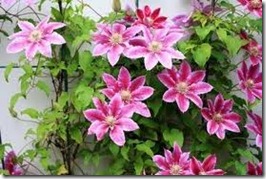Clematis grows into woody vines that produce large, showy blossoms in a variety of colors. Clematis vary as to when they produce blossoms and whether they develop buds over the winter or after the frosts and cold have given way to spring. Clematis that blossom in early to midspring, usually April or May, produce blossoms on the previous season’s wood, and cold protection will give you a good batch of blossoms, especially in eastern Washington and Oregon, where winter temperatures can drop very low. Clematis that don’t bloom until late May or later don’t need winter protection, as they produce flowers on the spring’s new growth, but do need pruning late in the winter.
- Difficulty:
- Moderately Easy
Instructions
things you’ll need:
- Mulch
- Pruning shears
Early-Blooming Clematis
- Replenish the mulch around the plants to a depth of 2 to 3 inches and build a mound of mulch around the base of the plant. Mulch helps to keep the crown of the plant protected during the worst of winter’s cold.
- Water the plant leading up to the first frost of the season. Clematis needs about 1 inch of water per week. The date of first frost can vary greatly in the Pacific Northwest, depending on where you live. For example, Seattle generally receives its first frost in early to mid-November, whereas Spokane’s first frost generally occurs in early October. Contact your county extension office or the National Climatic Data Center for more information about what to expect for frosts and freezes in your area.
- Remove the plant from the trellis in the fall and lay the vines on the ground. Cover it with several inches of mulch to protect the buds from cold damage. In the spring, uncover the plant and place it back on the trellis.
Late-Blooming Clematis
- Check the mulch around the plant in the autumn and replenish as needed to keep it about 2 to 3 inches. Build a mound of mulch around the base of the plant to provide extra cold protection for the roots.
- Water the plant so that it receives at least 1 inch of water per week leading up to the first frost of the season.
- Cut back the vines to 3 inches from the ground in late winter. When spring arrives, new growth will develop and provide you with the next season of flowers.
Tips & Warnings
-
If you’re not sure what kind of clematis you have, check the tag that came with the plant. Plants labeled as type 1, 2, A or B produce flowers on old wood, and cold protection will help give you a good display the following spring. Clematis labeled as type 3 or C flower on new growth and perform best with a late-winter pruning.


Deprecated: strpos(): Passing null to parameter #1 ($haystack) of type string is deprecated in /home/agriviek8Qv/agriviet.net/public_html/wp-includes/comment-template.php on line 2522